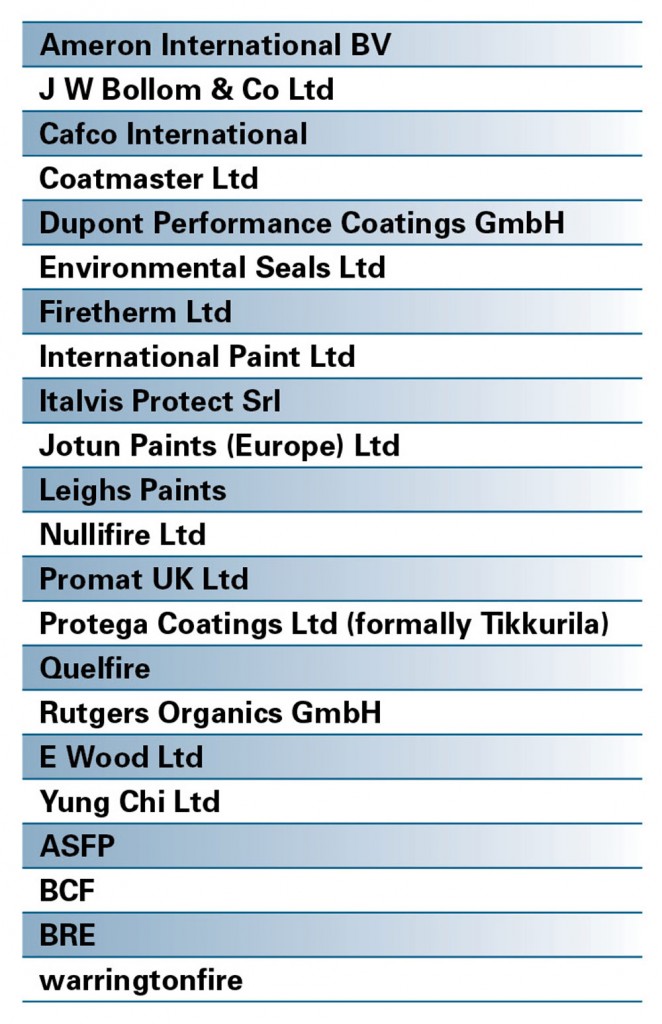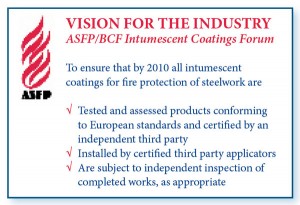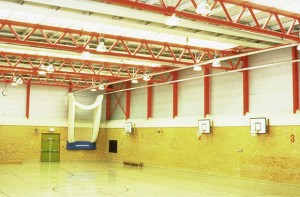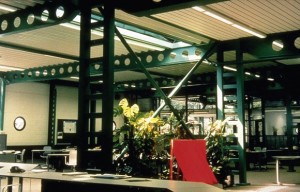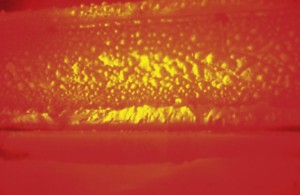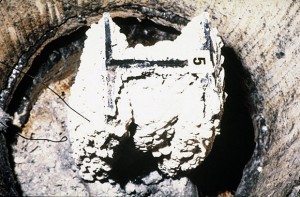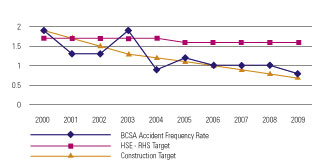Projects and Features
Reliability of Intumescent Fire Protection Products
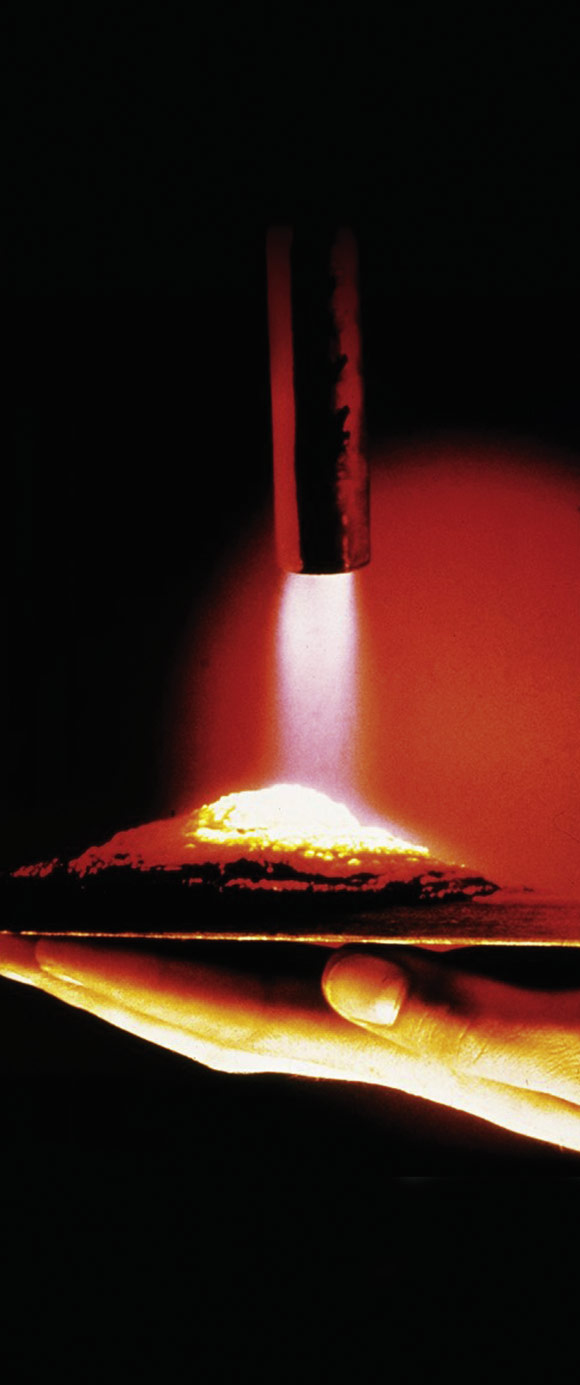
In this demonstration, the intumescent material foams under a blowtorch, but the substrate underneath the coating remains cool enough to be held
Debbie Smith of BRE Fire and Security and Geoff Deakin of Warringtonfire report on tests on 15 water based intumescent fire protection products available on the UK market.
Intumescent fire protection technology continues to develop at a pace where new products offering greater performance with lower thicknesses emerge into the market with frequent regularity. This continuing trend of ‘using less to do more’ often raises questions amongst designers and specifiers as well as regulators and enforcers about the reliability of the products and their performance.
These products, which must be described as ‘high technology’ by comparison with most other forms of fire protection, tend to be value engineered for performance which places additional demands upon those who are responsible for their evaluation and their application.
Against this background, and other challenges faced by the industry, not least the implications of new requirements from Europe, the various manufacturers and suppliers of thin film intumescent coatings have been meeting regularly with the support of Warringtonfire and BRE Fire and Security, to address the challenges.
Meetings have been taking place over a period of two years involving the most senior executives of the various companies and as a consequence of the regular venue (Stratford upon Avon) the activity was initially christened ‘The Stratford Initiative’. Recently, ‘The Stratford Initiative’ has been adopted jointly by the Association of Specialist Fire Protection (ASFP) and the British Coatings Federation (BCF) and has been given the title of The Intumescent Coatings Forum, the membership of which is given in Table 1.
Within the next two to three years, intumescent fire protection together with all other forms of structural fire protection will have to be CE marked under the Construction Products Directive if they are to be placed upon the European market. While CE marking is not mandatory within the UK, many manufacturers of intumescent fire protection work at a European, if not worldwide level. CE marking as proof of conformity, involving third party certification of the product, is viewed by the industry as the most effective way to demonstrate performance and reliability.
This does bring with it, however, the need for product performance evaluation utilising new harmonised European test standards that are more severe than those currently used in the UK. In line with other sections of the UK fire protection industry, the intumescent manufacturers/suppliers have conceded to ODPM that they accept that there should be no compensatory reduction in performance levels given in the regulatory guidance in Approved Document B (to the Building Regulations – England and Wales) to maintain the status quo. They accept that, in the future, to align with Europe, they will need to enhance product performance or increase the required product thicknesses, to satisfy similar fire resistance requirements.
Another matter of importance to the manufacturers/suppliers is the potential for undermining their product’s performance by application by contractors who do not have an understanding of the special requirements of the product and do not possess the skills to ensure that it is applied in the correct manner. As a consequence, the product may have inadequate adhesion (due to poor application or incompatibility of the primer or existing paint protection) or may not be applied to the correct thickness, within tolerances and with adequate controls over accuracy. To circumvent this danger, the industry has therefore agreed to collectively address this issue and has committed itself to ensure high standards of reliability for the installed product.
As a consequence of the Stratford discussions, the Intumescent Coatings Forum has set itself a vision for the future as follows:
To advance this, the Forum has taken a number of specific actions to ensure that standards of quality and reliability of intumescent products are maintained at the highest level. These include the following:
i) A position paper has been agreed relating to the fire testing and assessment of intumescent steel protection. Currently, there is no British Standard test and assessment method for this purpose and the ‘standard’ for the industry has been set by the ‘Yellow Book’, the ASFP publication “Fire protection for structural steel in buildings”(http://asfp.associationhouse.org.uk/default.php?cmd=210&doc_category=27). However, the process described in the Yellow Book has been conservative in terms of the evaluation of performance of intumescent steel protection and relates to a time when there were fewer products in the market at more significant thicknesses and when the testing and assessment process was basically carried out only by the two laboratories working together to ensure consistency of practices. The situation today is very different with many more products, tested in different ways and assessed by others than the test laboratories. The predictive capability has improved through more refined but competitive and different mathematical or physical models. To standardise the situation, the industry has developed and agreed to voluntarily adopt a new protocol as a basis for formulating claims in the market. By agreement to this protocol, the manufacturers/suppliers are setting the requirements that will impose new rigors and procedures on the laboratories and others involved in the process.
The industry protocol will be the basis of future recommendations in the Yellow Book since ASFP has agreed to amend it to follow the protocol. It will also reflect the new European requirements for European Technical Approvals and CE marking of products. The industry agreed Code of Practice is to be published jointly by ASFP and the BCF.
ii) The industry has agreed the methodology to be used for determining and presenting volume solids data. This will be a routine measurement made by the fire test laboratories at the time of test and will be presented in the test report. Volume solids will be presented in data sheets by manufacturers in a consistent manner. This eliminates any potential variations or confusion associated with the translation of the dry film thicknesses required for a given contract, to quantities of paint in liquid form.
iii) The most significant initiative ex Stratford, however, has been an agreement with warringtonfire and BRE Fire and Security to undertake independent market sampled product testing of water-based intumescent products.
Warringtonfire sampled a total of 15 different water-based intumescent products, available on the UK market, directly from the market. These were each applied to a common dimensioned short beam at a thickness specified by the manufacturer to be appropriate for providing the beam with 60 minutes fire protection. This was given as the time for the beam to reach the specified temperature used as the basis for the assessment of the product (typically 620°C). The manufacturers were able to make or witness the application process to ensure that it was to their satisfaction but the whole process was under the control of the laboratories. The results of this testing provided a ‘snapshot’ of the state of the industry. The achieved level of performance was compared with the manufacturer’s claim in relation to both the assessment and data sheets that are supplied to the market place. It needs to be appreciated that such a single test result does not provide a reliable indicator of a products overall performance across its range of thicknesses and steel section factors. Biases are possible from one end of the range to the other. Therefore, where the result from the single beam suggested a deficiency in providing less than 90% of the claimed performance (this value was agreed to allow for variability associated with testing), a more detailed test evaluation was completed involving reviewing the product performance across the range of steel section factors.
After completion of the agreed test programme and some further supplementary testing only one product at one level of Section Factor (HpA) gave results less than 90% of the claimed performance, but still gave a mean performance in excess of 100%. A modification of the assessment table has been agreed with the manufacturer of this product.
iv) The results of the exercise in iii) above has led to another initiative by the industry. All manufacturers/suppliers have voluntarily agreed that all the assessments used in support of their water-based and solvent-based products should be reviewed by warringtonfire and BRE Fire and Security against an agreed set of ‘acceptability criteria’. This will ensure that all current product assessments provide the same level of confidence in the product performance based upon the available test data.
‘The ASFP/BCF Intumescent Coatings Forum’ continues to make steps towards its vision for the industry in 2010. New initiatives to address better support for the installers of products and to validate applied thicknesses are planned. The first significant milestone, however, is the commitment to embrace the European requirements and work only with product performance claims to the new European standards by mid-2008.








